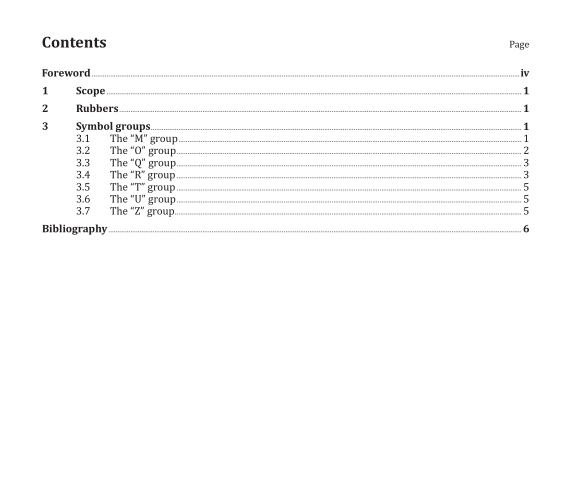BS ISO 1629:2013 pdf download.Rubber and latices — Nomenclature
This International Standard establishes a system of symbols for the basic rubbers in both dry and latex forms, based on the chemical composition of the polymer chain.
The purpose of this International Standard is to standardize the abbreviated terms used in industry,commerce, and government, and it is not intended to conflict with, but rather to act as a supplement to,existing trade names and trademarks.
NOTE 1 It is intended that in technical papers or presentations, the name of the rubber be used, if possible. It is intended that the symbols follow the chemical name for use in later references.
NOTE 2 The nomenclature of thermoplastic elastomers is described in ISO 18064. [1]
2 Rubbers
Rubbers, in both dry and latex forms, are grouped and symbolized on the basis of the chemical composition of the polymer chain in the following manner:
M rubbers having a saturated carbon chain of the polymethylene type
N rubbers having carbon and nitrogen in the polymer chain
NOTE At the time of publication, no rubber has so far been symbolized in the “N” group.
O rubbers having carbon and oxygen in the polymer chain
Q rubbers having silicon and oxygen in the polymer chain
R rubbers having an unsaturated carbon chain, e.g. natural rubber and synthetic rubbers derived at least partly from conjugated dienes
T rubbers having carbon, oxygen, and sulfur in the polymer chain
U rubbers having carbon, oxygen, and nitrogen in the polymer chain
Z rubbers having phosphorus and nitrogen in the polymer chain
3 Symbol groups
3.1 The “M” group
The “M” group comprises rubbers having a saturated chain of the polymethylene type. The following symbols are used:
ACM copolymer of ethyl acrylate (or other acrylates) and a small amount of a monomer which facilitates vulcanization (usually known as acrylic rubber)
AEM copolymer of ethyl acrylate (or other acrylates) and ethylene
ANM copolymer of ethyl acrylate (or other acrylates) and acrylonitrile
BIMSM terpolymer of isobutene, para-methylstyrene, and para-bromomethylstyrene
CM chloropolyethylene 1)
CSM chlorosulfonylpolyethylene
EBM ethylene-butene copolymer
EOM ethylene-octene copolymer
EPDM terpolymer of ethylene, propylene, and a diene with the residual unsaturated portion of the polymerized diene in the side chain
EPM ethylene-propylene copolymer
EVM ethylene-vinyl acetate copolymer 2)
FEPM copolymer of tetrafluoroethylene and propylene
FFKM perfluoro rubber in which all substituent groups on the polymer chain are fluoro, perfluoroalkyl, or perfluoroalkoxy groups
FKM fluoro rubber having substituent fluoro, perfluoroalkyl, or perfluoroalkoxy groups on the polymer chain
IM polyisobutene 3)
NBM fully hydrogenated acrylonitrile-butadiene copolymer (see 3.4.2)
SEBM styrene-ethylene-butene terpolymer
SEPM styrene-ethylene-propylene terpolymer
3.2 The “O” group
The “O” group comprises rubbers having carbon and oxygen in the polymer chain. The following symbols are used:
CO polychloromethyloxirane (usually known as epichlorohydrin rubber)
ECO copolymer of ethylene oxide (oxirane) and chloromethyloxirane (also known as epichlorohydrin copolymer or rubber)
GCO copolymer of epichlorohydrin and allyl glycidyl ether
GECO terpolymer of epichlorohydrin-ethylene oxide-allyl glycidyl ether
GPO copolymer of propylene oxide and allyl glycidyl ether (also known as polypropylene oxide rubber)
3.3 The “Q” group
The “Q” group is defined by inserting the name of the substituent group on the polymer chain prior to
the silicone designation. The following symbols are used:
FMQ silicone rubber having both methyl and fluorine substituent groups on the polymer chain
FVMQ silicone rubber having methyl, vinyl, and fluorine substituent groups on the polymer chain
MQ silicone rubber having only methyl substituent groups on the polymer chain, such as dimethyl
polysiloxane
PMQ silicone rubber having both methyl and phenyl substituent groups on the polymer chain
PVMQ silicone rubber having methyl, vinyl, and phenyl substituent groups on the polymer chain
VMQ silicone rubber having both methyl and vinyl substituent groups on the polymer chain
The letter for substituent group(s) on the polymer chain is inserted to the left of the code letter for
rubber with silicon and oxygen in the backbone (Q) in descending order of percent present, i.e. largest
nearest the “Q”.
NOTE In ISO 1043-1, [2] the symbol for silicone polymers is SI.
3.4 The “R” group
3.4.1 Description
The “R” group, in both dry and latex forms, is defined by inserting, before the word “rubber”, the name of the monomer or monomers from which the rubber was prepared (except for natural rubber). The letter preceding the letter “R” signifies the conjugated diene from which the rubber was prepared (except for natural rubber). Any letter or letters preceding the diene letter signifies the comonomer or comonomers,substituent groups, or chemical modifications. The designation may be prefixed by the letter “E” and a hyphen to signify an emulsion-polymerized rubber or the letter “S” and a hyphen to signify a solutionpolymerized rubber.
For latices, the designated symbol is followed by the word latex, e.g. “SBR latex”.
The symbols given in 3.4.2 to 3.4.4 are used.BS ISO 1629 pdf download.ISO 1629-2013 pdf download
